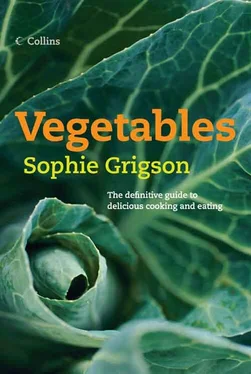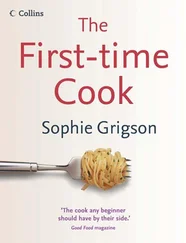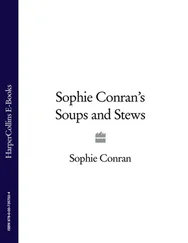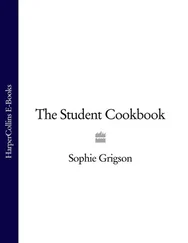Chips are fried twice, the first time at a gentle heat to just soften them right through to the centre, the second time at a higher heat to brown the outside. You can do the first batch of frying ahead of time, but leave the second hot, hot, hot session until just before serving. If you use an electric deep-fryer the temperatures are easy to gauge. If you don’t then it is worth investing in a food thermometer.
Good varieties for chips include King Edward, Maris Piper and Désirée. Cara give a slightly waxier texture which I love but if you prefer a fluffier centre stick with one of the first three.
Serves 3–4
3 large potatoes
sunflower or vegetable oil for deep-frying
salt
Peel the potatoes and cut into slices about 1 cm ( 1/ 2in) thick. Cut lengthways into batons of about the same thickness. Cover with cold water to prevent browning, until you are almost ready to cook them.
Set the oil to heat up. The right heat for the first fry is 150°C/300°F. Drain the potatoes then dry them thoroughly on kitchen paper or clean tea-towels. Deep-fry in several batches so that the temperature of the oil is not lowered too much, allowing them to cook for about 4 minutes, without browning, until tender right through. Drain on kitchen paper and leave to cool.
Just before serving, reheat the oil, this time to 180°C/350°F. Deep-fry the chips, again in batches, until golden brown.
The only thing you need to do now is drain and salt the chips. The best way to do this is in a large brown paper bag. Yes, honestly. Tip the chips into the bag, add plenty of salt, fold over the top and shake – the bag absorbs excess fat, and the salt gets evenly distributed. If you don’t have a brown paper bag to hand, drain the chips briefly on a triple layer of kitchen paper, then sprinkle with salt. Serve straightaway while still good and hot.
Baked potatoes are fabulous comfort food, and so easy. Just pop them into a hot oven when you get home from work, go and have a bath or a glass of wine, or whatever unwinds you after a hard day, then an hour later they emerge, steaming hot, crisp outside and gorgeously tender inside. Whether you dish them up as the main part of a meal with a sumptuous topping, or as a side order, baked potatoes are warming and reassuring, and of course, they taste just fine too.
For each person you need one large baking potato – any large maincrop potato will do the job nicely. Prick the skin all over with a fork to prevent it bursting during cooking. Now you have choices to make. You can a) leave the potato just as it is, or b) dampen it and rub salt into the skin – this gives a deliciously salty skin – or c) rub oil all over the skin, to make the skin crisper, or d) go for both oil and salt or e) wrap the potato in foil for a tender, soft-skinned potato.
Once you’ve reached a decision and finished preparing your potato, bake for 50–60 minutes or until tender right through. Test by pushing a skewer into the centre. Once the potato is cooked, cover with a cloth and let it sit for 5 minutes before cutting open – this makes the flesh fluffier and lighter.
One final point – if you’re rushed for time, push a skewer lengthways through the centre of the potato before putting it into the oven. The skewer conducts heat directly to the centre of the potato so that it cooks more quickly.
Roast new potatoes with thyme and lemon
Little new potatoes are delicious roasted in the oven. They cook to a wonderful, melting tenderness that is just irresistible. The sharpness of the lemon pieces is particularly good with them.
Serves 4
1 kg (21/4 lb) small new potatoes
6 sprigs thyme
1 lemon
4 tablespoons extra virgin olive oil
salt
Preheat the oven to 220°C/425°F/Gas 7. Put the potatoes and thyme in a roasting tin or ovenproof dish – it should be large enough to take them all in a single layer. Cut the lemon into 8 wedges, then cut each wedge into 3 pieces. Add them to the potatoes then drizzle over the olive oil and sprinkle with salt. Turn the potatoes and lemon until all are coated in oil.
Bake for 40–45 minutes, stirring twice during that time, until the potatoes are patched with brown and very tender. Serve hot.
Indian stuffed potato cakes
Wow – these Indian potato cakes are so utterly wonderful, yet they are made with the most ordinary of vegetables: potatoes, carrots, peas and onions. Clever spicing is all it takes, that and a little ingenuity. They are easy to make, look good, and taste even better. I like them just as they are, but if you want to dress them up a little more, adding another beguiling layer of taste, make the sweet sour tamarind and date sauce overleaf to serve with them.
Serves 4 as a main course, 8 as a starter
650g (1 lb 7oz) floury potatoes
40g (11/2 oz) plain flour
1/2 teaspoon salt
vegetable oil for frying
Filling
115g (4 oz) lightly cooked fresh peas or frozen peas, thawed
115g (4 oz) carrots, roughly chopped
1 onion, chopped
1 red or green chilli, deseeded and chopped
2cm (3/4 in) piece fresh root ginger, grated
1 large clove garlic, chopped
11/2 tablespoons sunflower or vegetable oil
1 teaspoon ground cinnamon
1 teaspoon ground cumin
juice of 1/2 large lime
2 tablespoons chopped coriander leaves
salt
First boil the potatoes in their skins until tender. Drain, then pull off the skins and mash the potatoes thoroughly. Work in the flour and salt to form a malleable ‘pastry’. Divide into 16 pieces. Oil your hands lightly. Take one of the pieces of potato dough, roll into a ball, then flatten it to form a circle that’s roughly 8cm (3in) in diameter. Repeat with the rest of the portions and then cover with a tea-towel until needed.
While the potatoes are cooking, make the filling. Pile all the vegetables, chilli, ginger and garlic into the processor and pulse until finely chopped, but not so fine that they form a purée. Heat the oil in a frying pan and add the chopped veg. Stir over a moderate heat for about 5 minutes, then stir in the cinnamon and cumin. Continue cooking for another 5 minutes or so, then season with salt. Take off the heat, cool slightly, then stir in the lime juice and coriander. Taste and adjust seasoning. Divide into 8.
Take one of the circles of potato dough, mound an eighth of the filling in the centre, then cover with a second disc of potato. Pinch the edges together to seal. Roll back into a ball, then flatten slightly to form a potato cake that’s roughly 2.5 cm (1 in) thick. Repeat with the remaining dough and filling.
Heat 2 tablespoons oil in a heavy frying pan over a moderate heat. Lay the potato cakes in the pan, without overcrowding. The oil should sizzle as they come into contact with it. If it is too cool, the cakes will stick to the pan. Leave them to cook – without moving around – for 3–4 minutes, then turn and brown the other side.
Serve while still hot on their own, or with the tamarind and date relish below.
This is a sweet sharp relish that goes well with all kinds of spicy foods. And with a slice of good cooked ham or a gammon steak. Not spicy, not Indian at all, but a happy match.
Serves 6–8
40 g (11/2 oz) tamarind pulp, or 4 tablespoons ready-made tamarind purée
Читать дальше












